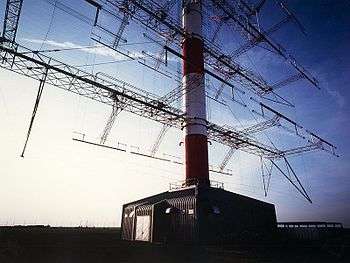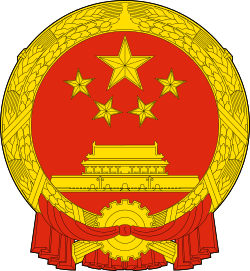State Administration of Press, Publication, Radio, Film and Television
| State Administration of Press, Publication, Radio, Film and Television | |||||||||||||||
| Traditional Chinese | 國家廣播電影電視總局 | ||||||||||||||
|---|---|---|---|---|---|---|---|---|---|---|---|---|---|---|---|
| Simplified Chinese | 国家广播电影电视总局 | ||||||||||||||
| |||||||||||||||
| General Administration of Press and Publication, Radio, Film, and Television | |||||||||||||||
| Traditional Chinese | 國家新聞出版廣播電影電視總局 | ||||||||||||||
| Simplified Chinese | 国家新闻出版广播电影电视总局 | ||||||||||||||
| |||||||||||||||
The State Administration of Press, Publication, Radio, Film and Television of the People's Republic of China (SAPPRFT), formerly known as the State Administration of Radio, Film, and Television (SARFT), is an executive branch under the State Council of the People's Republic of China. Its main task is the administration and supervision of state-owned enterprises engaged in the television, radio, and film industries.
It directly controls state-owned enterprises at the national level such as China Central Television, China National Radio, China Radio International, as well as other movie and television studios and others non-business organizations.
It is also responsible for censoring any materials that offend the sensibilities of the Chinese government or Chinese cultural standards. An example of such activity is the summer 2007 controversy over the television talent show First Heartthrob.[1]
History
In 1986 the State Council Ministry of Culture, Film Council and the Department of Radio and Television merged to form the Film and Television Bureau. On 25 June 1998 Film and Television Bureau reorganized as the State Administration of Radio, Film and Television. In March 2013 the State Council announced plans to merge State Administration of Radio, Film, and Television with the General Administration of Press and Publication to form the General Administration of Press and Publication, Radio, Film, and Television.
Primary duties
The official functions of SARFT are:
- Research and development of radio and television publicity and video creation policies and grasp of public opinion; guide radio and television publicity and radio and television writing and to coordinate the planning of their subject matter; Steering Radio Film and Television management system.
- Research and the drafting of the management of Radio Film and Television industry laws and regulations; development of Radio Film and Television management regulations and career development planning; supervision and management of radio and television programs, satellite TV included, and communication to the public through information network of audio-visual programs; responsible for broadcasting radio and TV stations broadcast radio and television programs and is responsible for the content of import management audit.
- Approval above the county level (including county-level) radio and television organizations and film, radio and television programs, television production units in the establishment and revocation; organizations to review broadcast on radio and television movies, dramas and other programming content and quality; distribution and cancellation of filmmaking, release permits and television production, distribution license.
- Management of Radio, Film and Television scientific and technological work, formulate the relevant technical policies and standards to guide application of Radio, Film and Television Systems high-tech research and development applications; study of Radio Film and Television in economic policy.
- According to the state's overall planning and macro-policies and laws and regulations, on the radio and television network dedicated to a specific planning and management; development of radio and television network dedicated specific policies, regulations and technical standards to guide the construction and development work classification to ensure that radio and television programs Safety broadcast; commissioned by the Ministry of Information Industry, the preparation of radio and television-specific bands in the planning, assigning radio and television frequencies (channels) and power and other technical parameters; participate in the development of national information network of the master plan.
- The leadership of the Central People's Broadcasting Station, China Radio International and China Central Television, its major propaganda coordination and inspection, unified organization and management of the transmission coverage of its programs.
- Study the establishment of Radio, Film and Television system of foreign affairs of the relevant provisions; management and guidance of Radio, Film and Television of foreign and Hong Kong and Macao Special Administrative Region and Taiwan region, exchanges and cooperation.
- Undertake the CPC Central Committee, other matters assigned by the State Council.
Technical details
The SARFT plays a similar role in China as TDF Group plays in France, or Crown Castle plays in the US or Australia. The SARFT owns and operates, as well as manages many thousands of MW, FM, TV and Shortwave relay transmitters in China (as well as those leased abroad for external broadcasting).
ALLISS deployment

Recently, the SARFT has decided to switch over to using ALLISS technology for international broadcasting in SE and NE Asia.
SARFT's ALLISS deployment
- 2003: China
- Low Band Modes (HR) : 4/4, 2/4, 4/2, 2/2
- High Band Modes (HR) : 4/4, 2/4, 4/2, 2/2
- Band coverage: 5.9 MHz to 26.1 MHz
- Note that the SARFT did not acquire the highest directivity models of HR 6/4/1 type.
- 2009: Cuba—The SARFT is said to have received a contract from the Chinese Foreign Affairs Department to replicate an ALLISS module in Cuba at an undisclosed location. This is according to Glen Hauser's World of Radio transmission of 25 June 2009.
The ALLISS system is a fully rotatable antenna system for high power shortwave radio broadcasting in the 6 MHz to 26 MHz range. An ALLISS module is a self-contained shortwave relay station that is used for international broadcasting.
ALLISS is a special design case of HRS type antennas. True ALLISS systems have solid radiators (horizontal radiating elements) versus tensioned flexible (open) radiators found with all other variations of ITU HRS type antennas systems. The names is based on a concatenation of two French villages ALLouis and ISSoudun.
CMMB deployment
China Multimedia Mobile Broadcasting (CMMB) is a mobile television and multimedia standard developed and specified in China by the State Administration of Radio, Film, and Television (SARFT).[2] It is based on the Satellite and Terrestrial Interactive Multiservice Infrastructure (STiMi), developed by TiMiTech, a company formed by the Chinese Academy of Broadcasting Science.[3][4] Announced in October 2006,[2] it has been described as being similar to Europe's DVB-SH standard for digital video broadcast from both satellites and terrestrial 'gap fillers' to handheld devices.[4]
It specifies usage of the 2.6 GHz frequency band and occupies 25 MHz bandwidth within which it provides 25 video and 30 radio channels with some additional data channels.[4] Multiple companies have chips that support CMMB standard - Innofidei who was the first with a solution March 28, 2007, Siano Mobile Silicon(with the SMS118x chip family, which support diversity and have superb performance) and more .[5][6]
Role in regulating film, television, and internet content
The State Administration of Radio, Film, and Television issues mandatory guidelines for media content. In 2011 and 2012 it limited the number of reality television programs and of historical dramas expressing particular disapproval of programs with a plot twist that involved time travel back to a Chinese historical era.[7] This decree resulted in cancellation of a number of planned films with historical drama plots.
It issued a directive on 30 March 2009 to highlight 31 categories of content prohibited online, including violence, pornography, content which may "incite ethnic discrimination or undermine social stability". Some industry observers believe that the move was designed to stop the spread of parodies or other comments on politically sensitive issues in the runup to the anniversary of the 4 June Tiananmen Square protests.[8]
It issued a directive named "SAPPRFT's Opinions On Strengthening The Programme Management of Satellite Television Channels" in 2011, aiming at over-turning the over-emphasis on purely entertainment programmes in the satellite television channels in China.
See also
References
- ↑ Landreth, Jonathan, and AP, "China cuts surgery-based reality shows", The Hollywood Reporter, August 29, 2007. Retrieved 2016-04-23.
- 1 2 "China releases mobile TV industrial standard" (Press release). Interfax China. 2006-10-25. Retrieved 2007-04-14.
- ↑ "TiMi Technologies Co. Ltd.". Academy of Broadcasting Science. 2008-01-31. Retrieved 2008-06-08.
- 1 2 3 Mike Clendenin (2006-12-18). "China's mobile-TV spec similar to Europe's". EETimes. Retrieved 2007-04-14.
- ↑ "China releases first mobile TV chip based on CMMB standard - SARFT official" (Press release). Interfax China. 2007-03-28. Retrieved 2007-04-14.
- ↑ Cai Yan (2007-03-29). "Chip supports China's CMMB mobile TV". EETimes. Retrieved 2007-04-14.
- ↑ Edward Wong (January 6, 2012). "China: TV Limits May Hit the Web". The New York Times. Retrieved January 7, 2012.
- ↑ Vivian Wu (3 April 2009). "Censors strike at internet content after parody hit". South China Morning Post.
